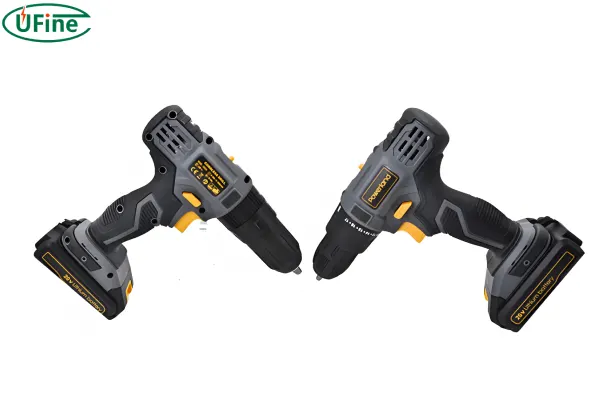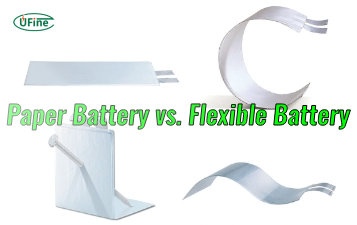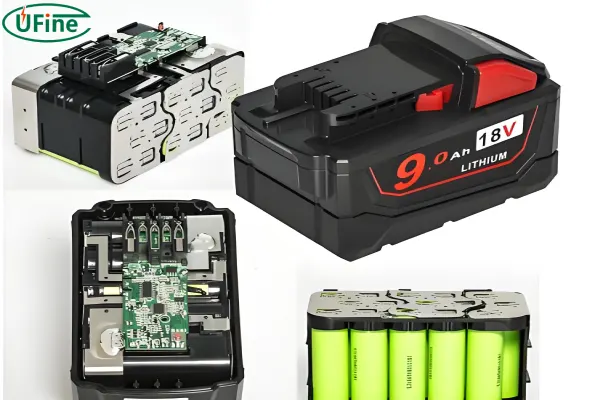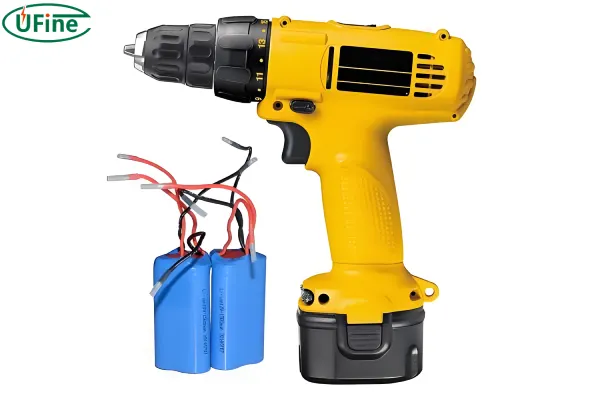Power tools are essential for any DIY enthusiast or professional tradesperson. Whether you’re drilling, sawing, or sanding, a reliable power source is crucial. This is where power tool batteries come in. They offer the freedom to work without being tethered to a power outlet, making your tasks more flexible and efficient. Let’s dive into everything you need to know about power tool batteries, their types, and how to choose the best one for your needs.

Part 1. What are power tool batteries?
Power tool batteries are rechargeable cells designed to power cordless tools. They’re like the lifeblood of your power tools, providing the juice needed to get the job done. Understanding the different types of power tool batteries can help you make an informed decision when purchasing or replacing your batteries.
Part 2. Types of power tool batteries
Let’s break down the main types of power tool batteries you’ll come across.
1.Nickel-Cadmium (NiCd) Power Tool Batteries
Nickel-Cadmium batteries are the granddaddies of rechargeable batteries used in power tools. They’ve been around for a while and have some unique features.
Advantages:
- Durability: These batteries are known for their toughness and ability to handle high loads.
- Cost: Generally, they are cheaper than other types.
Disadvantages:
- Memory Effect: NiCd batteries suffer from a memory effect, which means their capacity reduces over time if not fully discharged before recharging.
- Environmental Impact: They contain toxic metals, so disposal and recycling can be a headache.
2. Nickel-Metal Hydride (NiMH) Power Tool Batteries
Nickel-Metal Hydride batteries are a step up from NiCd batteries, offering several improvements.
Advantages:
- Higher Capacity: They store more energy compared to NiCd batteries.
- Less Toxic: More environmentally friendly.
Disadvantages:
- Self-Discharge: They tend to lose their charge faster when not in use.
- Memory Effect: While less pronounced than in NiCd, it’s still there.
3. Lithium-Ion (Li-Ion) Power Tool Batteries
Lithium-Ion batteries are the rock stars of the power tool world. They’re the most popular choice for modern power tools.
Advantages:
- High Energy Density: They pack more energy into a smaller size, making them lightweight and compact.
- No Memory Effect: You can recharge them at any time without losing capacity.
- Longer Lifespan: They outlast NiCd and NiMH batteries.
Disadvantages:
- Cost: They’re pricier upfront.
- Sensitivity: They require proper battery management systems to prevent overcharging and overheating.
Part 3. Key features to consider
When choosing power tool batteries, several key features can make a big difference in performance and usability. Here’s what you should keep an eye on.
1. Voltage
The voltage of a battery determines how much power it can provide. Higher voltage means more power, which is crucial for demanding tasks. Common voltages for power tool batteries range from 12V to 20V, with some professional-grade tools going up to 36V or more.
2. Capacity
Capacity is measured in ampere-hours (Ah) and indicates how long the battery will last on a single charge. A higher Ah rating means a longer runtime. For example, a 4.0 Ah battery will last twice as long as a 2.0 Ah battery under the same conditions.
3. Charge Time
How quickly a battery can be recharged is also important. Fast-charging batteries can save a lot of downtime, allowing you to get back to work sooner. Some advanced chargers can fully recharge a battery in less than an hour.
4. Compatibility
Not all batteries fit all tools. It’s crucial to ensure that the battery you choose is compatible with your power tool brand and model. Many manufacturers design their batteries to be used only with their tools, so check for compatibility before purchasing.
5. Maintenance and Care
To get the most out of your power tool batteries, proper maintenance and care are essential. Here are some tips to help you prolong the life of your batteries:
- Regular Charging: Avoid letting your battery discharge completely. Regularly charge it to maintain optimal performance.
- Proper Storage: Store batteries in a cool, dry place. Extreme temperatures can negatively affect their lifespan.
- Cleaning: Keep the battery contacts clean to ensure a good connection with your tools and chargers.
- Usage: Use the battery regularly. Long periods of inactivity can lead to capacity loss.
Part 4. Comparing different power tool battery types
Let’s put it all together and compare the different battery types to see how they stack up against each other.
| Feature | Nickel-Cadmium (NiCd) | Nickel-Metal Hydride (NiMH) | Lithium-Ion (Li-Ion) | Lithium-Iron Phosphate (LiFePO4) |
|---|---|---|---|---|
| Energy Density | Low | Medium | High | High |
| Weight | Heavy | Medium | Light | Light |
| Memory Effect | Significant | Moderate | None | None |
| Self-Discharge Rate | High | Medium | Low | Low |
| Cycle Life | 500-1000 cycles | 300-500 cycles | 500-1500 cycles | 2000+ cycles |
| Charging Time | Moderate | Moderate | Fast | Fast |
| Cost | Low | Medium | High | High |
| Environmental Impact | Toxic (Cadmium) | Less Toxic (No Cadmium) | Environmentally Friendly | Environmentally Friendly |
| Usage Temperature | Wide range | Wide range | Wide range | Wide range |
Part 5. Why choose lithium batteries?
Lithium-Ion batteries have become the go-to choice for most power tool users, and for good reason. Here’s why:
- Efficiency: They provide a higher energy density, meaning they can power your tools longer without adding much weight.
- Convenience: No memory effect allows you to recharge them at any point, keeping your tools ready to go.
- Durability: They offer a longer lifespan, which means you won’t need to replace them as often.
Part 6. Factors Affecting Battery Performance
Several factors can influence the performance of your power tool batteries. Understanding these can help you make better choices and get the most out of your batteries.
1. Temperature
Extreme temperatures can reduce battery efficiency and lifespan. It’s best to use and store batteries at moderate temperatures.
2. Usage Patterns
Frequent use and recharging can wear out batteries faster. However, irregular use can also be detrimental, as batteries can lose capacity if left unused for long periods.
3. Charging Practices
Overcharging or using incompatible chargers can damage batteries. Always use the charger recommended by the battery manufacturer, and avoid leaving batteries on the charger for extended periods after they’re fully charged.
Part 7. How to choose the right power tool battery?
Choosing the right power tool battery depends on your specific needs and preferences. Here are some tips to help you decide:
- Assess Your Needs: Consider the type of tasks you’ll be performing. Heavy-duty tasks may require higher voltage and capacity.
- Check Compatibility: Ensure the battery is compatible with your tools. Stick to the same brand if possible to avoid compatibility issues.
- Evaluate Cost vs. Benefit: While lithium-ion batteries are more expensive, their long-term benefits might justify the higher initial cost.
- Read Reviews: Look for reviews from other users to get a sense of the battery’s performance and reliability.
Part 8. Conclusion
Power tool batteries are a crucial component of any cordless tool setup. By understanding the different types, features, and maintenance practices, you can ensure you choose the right battery for your needs and get the best performance out of your tools. Whether you’re a DIY enthusiast or a professional tradesperson, having the right battery can make all the difference in your work.
Related Tags:
More Articles

Paper Battery vs. Flexible Battery: What’s the Difference and Which Is Better?
Paper vs. flexible batteries: learn the key differences, benefits, and which power source fits best for wearables, sensors, and smart tech.
What to Know Before Buying a Tiny LiPo Battery for Your Project
Tiny LiPo batteries are powerful and compact. Learn how to choose the right one for your project with specs, safety, and charging tips.
Bloated LiPo Battery: Will It Explode?
Will a bloated LiPo battery explode? Discover the causes, risks, safety steps, and expert tips to avoid disaster and protect your gear. Must-read safety guide!
12V 100Ah Lithium Ion Battery Price: Full Guide
Learn about 12V 100Ah lithium-ion battery price, from cost ranges to best brands, hidden fees, and how to get the best deal. A must-read for smart buyers!
Resistance and Conductivity: What It Means for Your Lithium Batteries
Resistance and conductivity impact lithium battery performance, lifespan, and safety—learn how they work and why they matter.





